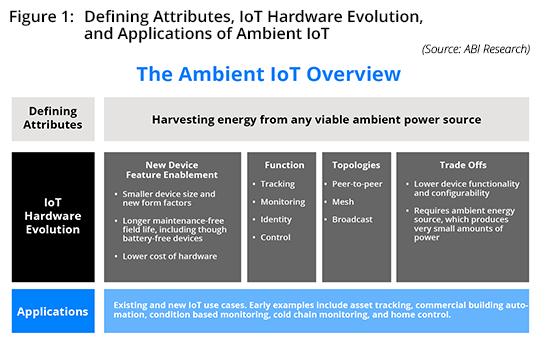Bluetooth SIG Releases Market Research Note on Ambient IoT
|
NEWS
|
In January 2024, the Bluetooth Special Interest Group (SIG) released a Market Research Note (MRN) on the topic of Ambient Internet of Things (IoT), a new class of IoT devices. The MRN, authored by ABI Research, lays out the Bluetooth SIG’s position on Ambient IoT by providing a precise working definition, laying out the need for this new class of devices, assessing the current use case landscape, and concluding with the next steps both for the broader IoT ecosystem and for the Bluetooth SIG itself as a standards body with a large member ecosystem.
Bluetooth SIG Positioning Its Appeal for the Broader IoT Ecosystem
|
IMPACT
|
In the MRN, the Bluetooth SIG defines Ambient IoT in the following way: “The Ambient Internet of Things (IoT) refers to a new class of IoT devices primarily powered by harvesting ambient energy from radio waves, light, motion, heat, or any other viable ambient energy source.” The definition acknowledges that Ambient IoT devices can come in a wide variety of formats, with the sole requirement that Ambient IoT devices can sustain themselves throughout their lifecycle by harvesting ambient energy. This use of energy harvesting enables device makers to create additional design features that would not be possible to achieve with existing IoT.

While the Bluetooth SIG has engaged with its ecosystem behind closed doors on the subject of Ambient IoT, this is the first time that it has clearly published a definition and its role. The timing is important, as ecosystem participants are increasingly active in discussing their own Ambient IoT roadmaps, including ways to power Ambient IoT devices—such as through Radio Frequency (RF) backscattering. The MRN engages the broader IoT ecosystem by providing a comprehensive definition and by highlighting Bluetooth® technology’s de facto dominance in the market. It also highlights the Bluetooth SIG’s desire to position itself as an organization that can support its members’ needs, including by assessing the need for standards. As noted in the MRN, standards could support device makers in RF energy harvesting, data formats, security, or many other topics.
The MRN’s release is important as a statement of intent from the body that standardizes Bluetooth® Low Energy (LE) technology that currently dominates the Ambient IoT market. The majority of vendors today building devices based on Ambient IoT technology use Bluetooth® LE technology, including Wiliot and Paragon ID. Wiliot is responsible for low-cost smart labels, while Paragon ID, on the back of its acquisition of French company UWINLOC, launched Bluetooth® LE and Ultra-Wideband (UWB) Real-Time Location System (RTLS) tags with a 20-meter energization range, which the company claimed at the time to be “twice that of any other tags in the market.”
The dominance of smart labels (primarily used for tracking) and RTLS tags in the Ambient IoT ecosystem highlights tracking as one of the early high-volume opportunity areas for Ambient IoT. As the Bluetooth SIG’s MRN highlights, however, there are many other potential use case areas where ambient energy harvesting is used as the primary energy source, such as Condition-Based Monitoring (CBM), smart buildings (e.g., EnOcean’s smart switches), or smart homes (e.g., voice control or remote controls).
Ambient IoT Requires More Innovation on Hardware and Broader Systems
|
RECOMMENDATIONS
|
There is a great deal of interest surrounding Ambient IoT from IoT developers and from the standards bodies supporting them, as noted in a recent ABI Insight, “Efforts toward Standardizing Ambient IoT Gain Pace, Promising More Attention in 2024.” The market potential is considerable, and will enable maintenance-free, sustainable, low-cost, and low-complexity devices that can change the way enterprises work or how they engage with consumers. Still, the MRN notes some of the challenges on the way to achieving this vision. These include:
- Market education
- Advances in energy harvesting
- Advances in low-power Integrated Circuits (ICs)
- Assessing the need for standards to support the developer ecosystem
- Approaches to facilitate sensor deployment and management in the field
- Approaches to facilitate data management from the vast quantities of data that can be produced
While Ambient IoT as a device class should create excitement from many in the ecosystem, there are many other aspects that will also need to be streamlined to ensure that this technology can reach its potential scale. Ambient IoT represents not only a shift in IoT hardware, but also a shift in energy, data, and software. Ambient IoT will represent a whole new way for enterprises to work, which will require a rethink or restructuring of their data management efforts. These are issues for an entire ecosystem to solve, not just device developers. The Bluetooth SIG’s MRN is another important step on the way to raising the necessary awareness that will make all of these elements eventually cohere.


